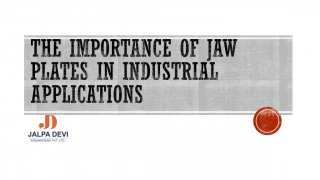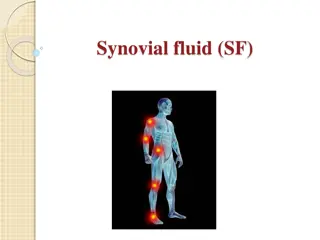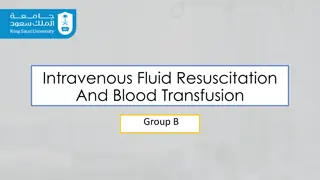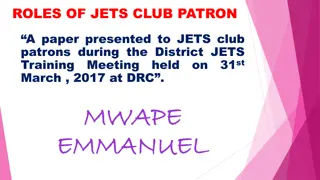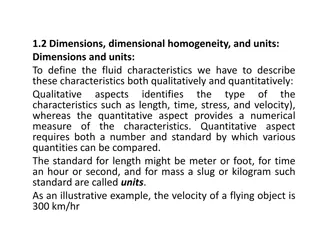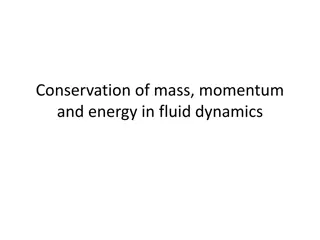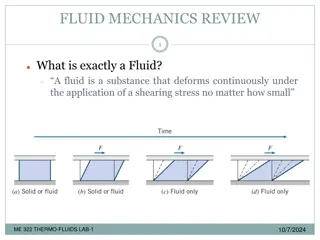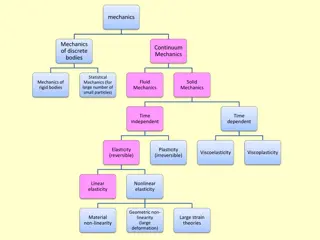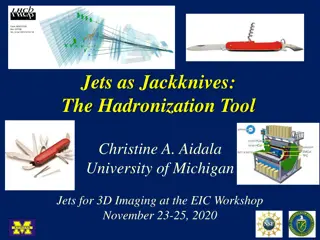Understanding the Impact of Jets on Plates in Fluid Mechanics
In fluid mechanics, the impact of jets on plates is a crucial concept where a stream of liquid at high velocity exerts a hydrodynamic force on plates or vanes. This force is affected by various factors like the orientation and movement of the plate relative to the jet. Key equations and problems related to this concept are discussed, providing a comprehensive understanding of the subject.
Download Presentation

Please find below an Image/Link to download the presentation.
The content on the website is provided AS IS for your information and personal use only. It may not be sold, licensed, or shared on other websites without obtaining consent from the author. Download presentation by click this link. If you encounter any issues during the download, it is possible that the publisher has removed the file from their server.
E N D
Presentation Transcript
CO: Describe the concept of Impact of jet on plate in various condition Chapter-04 IMPACT OF JET
Impact of Jets The jet is a stream of liquid comes out from nozzle with a high velocity under constant pressure. When the jet impinges on plates or vanes, its momentum is changed and a hydrodynamic force is exerted. Vane is a flat or curved plate fixed to the rim of the wheel 1. Force exerted by the jet on a stationary plate a) Plate is vertical to the jet b) Plate is inclined to the jet c) Plate is curved 2. Force exerted by the jet on a moving plate a) Plate is vertical to the jet b) Plate is inclined to the jet c) Plate is curved
From Newton's 2ndLaw: F = m a = m (V1- V2) / t Impulse of a force is given by the change in momentum caused by the force on the body. Ft = mV1 mV2= Initial Momentum Final Momentum Force exerted by jet on the plate in the direction of jet, F = m (V1 V2) / t = (Mass / Time) (Initial Velocity Final Velocity) = ( Q) (V1 V2) = ( aV) (V1 V2)
Plate is vertical to the jet F = If Plate is moving at a velocity of U m/s, F = F = aV2 F = a(V-U)2
Problems: 1. A jet of water 50 mm diameter strikes a flat plate held normal to the direction of jet. Estimate the force exerted and work done by the jet if a. The plate is stationary b. The plate is moving with a velocity of 1 m/s away from the jet along the line of jet. The discharge through the nozzle is 76 lps. 2. A jet of water 50 mm diameter exerts a force of 3 kN on a flat vane held perpendicular to the direction of jet. Find the mass flow rate.
Plate is inclined to the jet F FN N= F Fx x= F Fx x= = aV2sin = FNsin = FNcos
Plate is inclined to the jet F FN N= = a(V-U)2sin F Fx x= F Fx x= = FNsin = FNcos
Problems: 1. A jet of data 75 mm diameter has a velocity of 30 m/s. It strikes a flat plate inclined at 450to the axis of jet. Find the force on the plate when. a. The plate is stationary b. The plate is moving with a velocity of 15 m/s along and away from the jet. Also find power and efficiency in case (b) 2. A 75 mm diameter jet having a velocity of 12 m/s impinges a smooth flat plate, the normal of which is inclined at 600to the axis of jet. Find the impact of jet on the plate at right angles to the plate when the plate is stationery. a. What will be the impact if the plate moves with a velocity of 6 m/s in the direction of jet and away from it. b. What will be the force if the plate moves towards the plate.
Plate is Curved and Jet strikes at Centre F = ) F = aV2 (1+ cos
Plate is Curved and Jet strikes at Centre F = F = a(V-U)2 (1+ cos )
Problems: 1. A jet of water of diameter 50 mm strikes a stationary, symmetrical curved plate with a velocity of 40 m/s. Find the force extended by the jet at the centre of plate along its axis if the jet is deflected through 1200at the outlet of the curved plate 2. A jet of water from a nozzle is deflected through 600from its direction by a curved plate to which water enters tangentially without shock with a velocity of 30m/s and leaver with a velocity of 25 m/s. If the discharge from the nozzle is 0.8 kg/s, calculate the magnitude and direction of resultant force on the vane.
Plate is Curved and Jet strikes at tip F Fx x= 2 = 2 aV2 cos
Plate is Curved and Jet strikes at tip F Fx x= = aV2 (cos + cos )
Problems: 1. A jet of water strikes a stationery curved plate tangentially at one end at an angle of 300. The jet of 75 mm diameter has a velocity of 30 m/s. The jet leaves at the other end at angle of 200to the horizontal. Determine the magnitude of force exerted along x and y directions.
Force exerted by the jet on a moving plate Considering Relative Velocity, If < 900 Fx= = aVr1(Vr1 cos + Vr2 cos ) OR OR Fx= = aVr1(VW1 + VW2)
Force exerted by the jet on a moving plate Considering Relative Velocity, If = 900 Fx= = aVr1(Vr1 cos Vr2 cos ) OR Fx= OR = aVr1(VW1)
Force exerted by the jet on a moving plate Considering Relative Velocity, If = 900 Fx= = aVr1(Vr1 cos Vr2 cos ) OR Fx= OR = aVr1(VW1 VW2)
Impact of jet on a series of flat vanes mounted radially on the periphery of a circular wheel F = U) F = aV (V-
Impact of jet on a series of flat vanes mounted radially on the periphery of a circular wheel F = F = aV (V-U) (1+ cos )
Problems: 1. A jet of water of diameter 75 mm strikes a curved plate at its centre with a velocity of 25 m/s. The curved plate is moving with a velocity of 10 m/s along the direction of jet. If the jet gets deflected through 1650in the smooth vane, compute. a) Force exerted by the jet. b) Power of jet. c) Efficiency of jet. 2. A jet of water impinges a curved plate with a velocity of 20 m/s making an angle of 200with the direction of motion of vane at inlet and leaves at 1300to the direction of motion at outlet. The vane is moving with a velocity of 10 m/s. Compute. i) Vane angles, so that water enters and leaves without shock. ii) Work done per unit mass flow rate
Force exerted by the jet on a moving plate (PELTON WHEEL) Considering Relative Velocity, Fx= OR Fx= = aVr1(Vr1 Vr2 cos ) OR = aVr1(VW1 VW2) Work done / sec = F.U Power = F. U F.U mV2 Efficiency =
Problems: 1. A jet of water having a velocity of 35 m/s strikes a series of radial curved vanes mounted on a wheel. The wheel has 200 rpm. The jet makes 200with the tangent to wheel at inlet and leaves the wheel with a velocity of 5 m/s at 1300to tangent to the wheel at outlet. The diameters of wheel are 1 m and 0.5 m. Find i) Vane angles at inlet and outlet for radially outward flow turbine. ii) Work done iii) Efficiency of the system

 undefined
undefined




